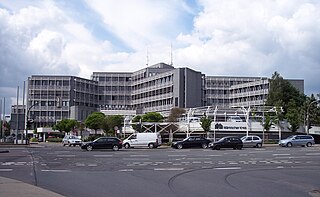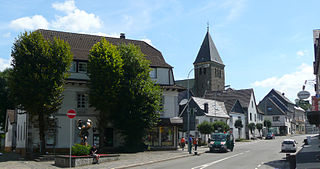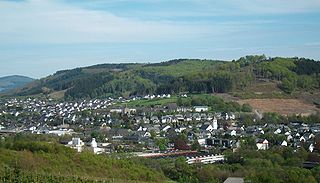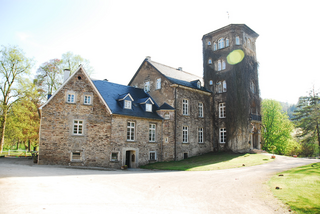
The Märkischer Kreis is a district (Kreis) in central North Rhine-Westphalia, Germany. Neighbouring districts are Unna, Soest, Hochsauerland, Olpe, Oberbergischer Kreis, Ennepe-Ruhr, and the city of Hagen.

Lüdenscheid is a city in the Märkischer Kreis district, in North Rhine-Westphalia, Germany. It is located in the Sauerland region.
Hochsauerlandkreis is a Kreis (district) in the east of North Rhine-Westphalia, Germany. Neighboring districts are Soest, Paderborn, Höxter, Waldeck-Frankenberg, Siegen-Wittgenstein, Olpe, Märkischer Kreis.
Siegen-Wittgenstein is a Kreis (district) in the southeast of North Rhine-Westphalia, Germany. Neighboring districts are Olpe, Hochsauerlandkreis, Waldeck-Frankenberg, Marburg-Biedenkopf, Lahn-Dill, Westerwaldkreis, and Altenkirchen.

The Lenne is a tributary of the river Ruhr in the Sauerland hills, western Germany. It has caused flooding in recent years.

The Sauerland is a rural, hilly area spreading across most of the south-eastern part of North Rhine-Westphalia, in parts heavily forested and, apart from the major valleys, sparsely inhabited.

Breckerfeld is a town in the district of Ennepe-Ruhr-Kreis, in North Rhine-Westphalia, (Germany). It is located in the southeasternmost part of the Ruhr area in northern Sauerland. The town is a member of Regionalverband Ruhr (association).

Meschede is a town in the Hochsauerland district, in North Rhine-Westphalia, Germany. It is the capital of the district Hochsauerlandkreis.

Hallenberg is a town in the Hochsauerland district, in North Rhine-Westphalia, Germany.

Olsberg is a town in the Hochsauerland district, in North Rhine-Westphalia, Germany.

Schmallenberg is a town and a climatic health resort in the High Sauerland District, Germany. By area, it is the third biggest of all cities and towns of the state of North Rhine-Westphalia and the second biggest of the region of Westphalia.

Bestwig is a municipality in the Hochsauerland district, in North Rhine-Westphalia, Germany.

Lennestadt lies in the Sauerland in southeast North Rhine-Westphalia and is a community in Olpe district. It is the district's most populous municipality. Lennestadt itself is not an actual town but a community which comprises several towns and villages.

Finnentrop is a Gemeinde (municipality) in Olpe district in North Rhine-Westphalia, Germany.

Kirchhundem is a German community in North Rhine-Westphalia. It belongs to the Olpe district.

Bad Berleburg is a town, in the district of Siegen-Wittgenstein, in North Rhine-Westphalia, Germany. It is one of Germany's largest towns by land area. It is located approximately 30 km (19 mi) northeast of Siegen and 35 km (22 mi) northwest of Marburg an der Lahn.

The Province of Westphalia was a province of the Kingdom of Prussia and the Free State of Prussia from 1815 to 1946. In turn, Prussia was the largest component state of the German Empire from 1871 to 1918, of the Weimar Republic and from 1918 to 1933, and of Nazi Germany from 1933 until 1945.

Altastenberg is a village in the borough of Winterberg in North Rhine-Westphalia, Germany. It is a state-recognised spa, is classed as one of the mountain villages in the borough and, at just under 800 m. above NN, is also the highest village in the Sauerland.

The Nuttlar–Frankenberg railway is a 62.3 km long line from Nuttlar on the Upper Ruhr Valley Railway in the German state of North Rhine-Westphalia via Winterberg and Allendorf (Eder) to Frankenberg (Eder) in the state of Hesse.
The Regionalverkehr Ruhr-Lippe GmbH (RLG) is a publicly owned company in Westphalia that operates several railway lines as an rail infrastructure company, conducts freight transport as rail transport company, and is active in bus transport.
























